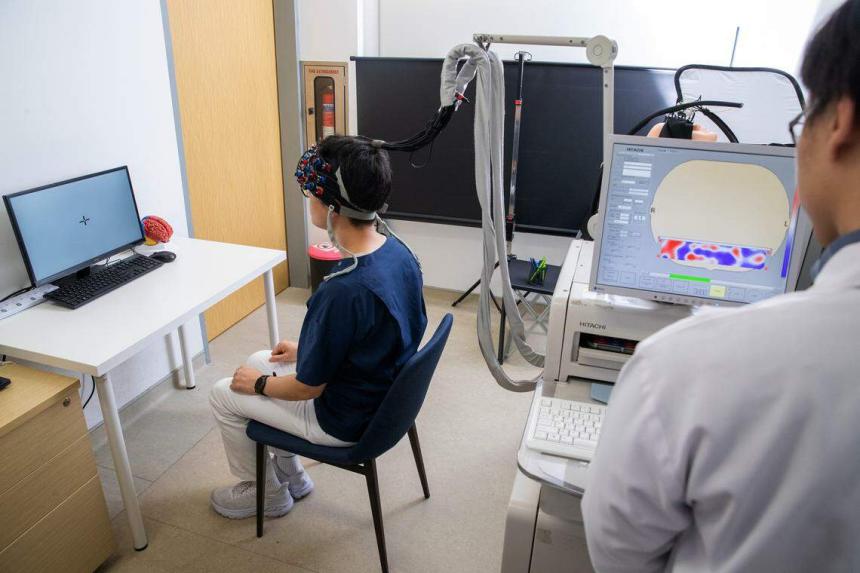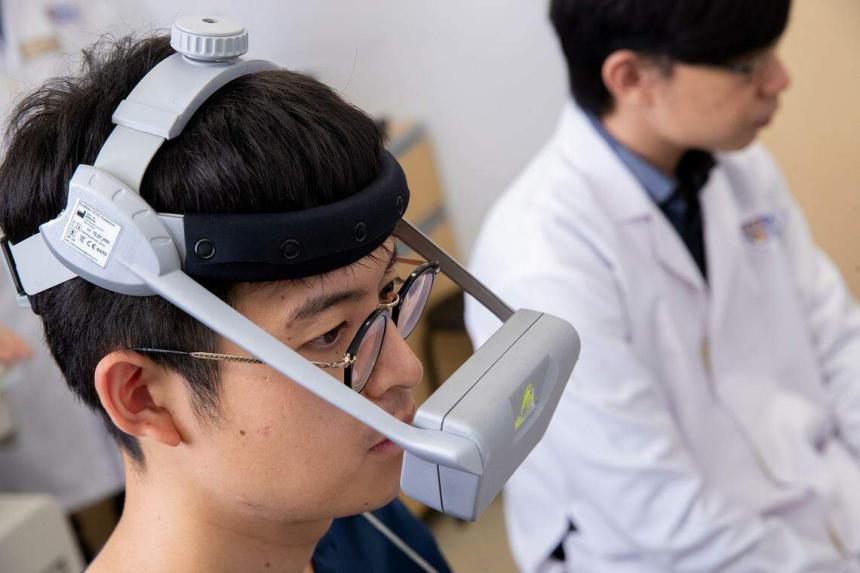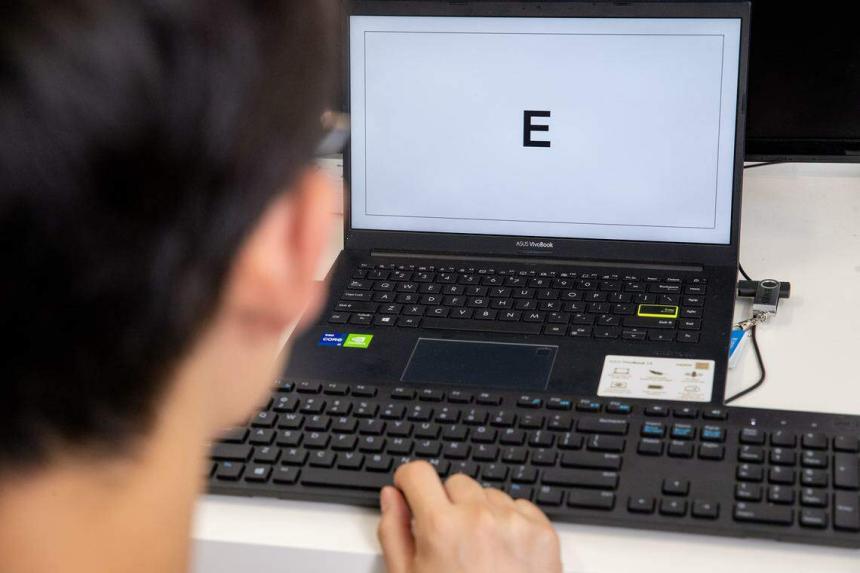SINGAPORE - Adults who suspect they have attention deficit hyperactivity disorder (ADHD) can now undergo a new series of tests designed to provide a more scientific diagnosis.
The process involves an infrared brain scan, an eye-tracker test and a continuous performance test – in addition to standard clinical interviews and self-report questionnaires.
The assessment is designed by the National University of Singapore’s Institute for Health Innovation and Technology (iHealthtech), which is the only place in the world to use a combination of the three tests to assess adults for ADHD.
Professor Roger Ho, principal investigator at iHealthtech, said it is difficult for doctors to decide if someone truly has ADHD or is over-reporting symptoms.
There is concern that people might exaggerate the seriousness of their symptoms to try and get their hands on controlled drugs commonly prescribed to treat the disorder but which also can lead to abuse, he added.
ADHD is a common neuro-developmental disorder that affects about 5 per cent of the world’s population, and about 4.9 per cent of Singaporean primary school pupils.
There are two types of ADHD – inattention or hyperactivity. Common symptoms of the disorder include procrastination, disorganisation, forgetfulness, restlessness and impulsivity.
Usually, a medical professional decides if a person meets the ADHD criteria listed in the Diagnostic and Statistical Manual of Mental Disorders (DSM-5). There will also be an evaluation of the person’s clinical history, and scores on standard questionnaires.
Prof Ho and his team began their research in June 2021 to study how infrared brain scans could help identify adults with ADHD.
The goal, he said, was to use tests that could scientifically measure ADHD symptoms, similar to tests for medical conditions like diabetes.
For instance, to find out if a patient has diabetes, doctors would administer a fasting blood test to measure blood sugar levels, he said.
Prof Ho said: “Psychiatry is the only medical discipline that diagnoses patients without objective diagnostic tools. So, this brain scan and eye tracker are like the prick test.
“There’s a predetermined value. It’s objective, no one can change that. If you’re below or close to this value, you may have ADHD.”
He added that he is helping to push for the wider use of such tools in psychiatric diagnoses.

The brain scan component of the diagnostic process was tested during a research study on about 75 healthy people, 45 adults with ADHD and no medication, and 75 adults with ADHD on medication, before it was included in the diagnostic process a year later in July 2022.
Since then, about 250 adults have undergone the new diagnostic process at iHealthtech, of whom 240 were diagnosed with ADHD. Prof Ho said most of them reported suffering from ADHD symptoms for years and came to him for a diagnosis.
Prof Ho said he has noticed an increase in the number of adults seeking professional help for ADHD, likely because those who had the condition struggled when they were stuck at home during the Covid-19 pandemic.
There is also greater awareness of the disorder now because of groups like local charity Unlocking ADHD, he added.
Said Prof Ho: “We have been using infrared brain scan technology for six years and we still use our service to diagnose depression, borderline personality disorder and dementia, but our number one demand now is adult ADHD.
“It outnumbers all other conditions.”
Since each of the three tests has an accuracy level of about 70 per cent, each one enhances the overall accuracy of the ADHD diagnosis, he added.
For the brain scan – the only test in the diagnostic process developed by Prof Ho and his team of researchers – a statistical method was used to analyse data collected and determine cut-off points for people with ADHD. This test has a 77.95 per cent accuracy, according to Prof Ho.
He added that psychiatric symptoms overlap in psychiatric disorders, so it is difficult for the test to achieve a higher accuracy.

For example, inattention can occur in ADHD or depression – the most common psychiatric condition – so the attention problems detected by the tests could be caused by other disorders.
“It is important that people who come for the ADHD assessment are screened for depression while older people are screened for dementia, and we look at which problem is more severe,” Prof Ho said.
The assessment at iHealthtech costs $350 on weekdays and $400 on weekends, and there is an average waiting time of about five months.
Prof Ho’s team has also embarked on promoting the technology in developing countries like Vietnam.
Unlocking ADHD founder Moonlake Lee, who was diagnosed with ADHD in 2019, said the diagnostic process costs about the same, compared with assessments done by some psychiatrists in private clinics, and the objective tests provide another avenue to be assessed for ADHD.
She said: “Having something like a printout, that is looked at objectively and scientifically, I think will give a bit more reassurance.”
When she received her diagnosis, she was given only a one-month prescription for medication. She wondered: “Is it for real?”
Some of her friends and family members were in disbelief when she told them she had ADHD because she had four degrees and had been married almost 30 years. She did not appear to fit the mould of a typical person with ADHD, she said.
“ADHD is a complex condition and anecdotally, it is common for missed diagnosis, misdiagnosis or even overdiagnosis,” Ms Lee said.
Prof Ho said it is important for adults with ADHD to seek treatment because they may be struggling with impairments that are treatable.
Some adults could be struggling in relationships because their partners cannot tolerate their inattention or they may lose focus while driving, but these symptoms may be alleviated with medication, he added.
Ms Lee said: “Sometimes you get diagnosed, not just for yourself, but for the people around you as well.”
How are the three objective tests conducted?
The diagnostic process consists of clinical interviews by the psychiatrist, a self-report questionnaire called the Conners’ Adult ADHD Rating Scale which measures the presence and severity of the disorder’s symptoms, and three objective tests that assess different biological aspects of ADHD.
If the person has self-reported symptoms that fulfil the Diagnostic and Statistical Manual of Mental Disorders (DSM-5) criteria for ADHD, but does not fulfil at least one of the objective tests, they are considered to have symptoms of inattention or hyperactivity instead of ADHD, and non-stimulant medication or ADHD coaching may be considered.
The diagnostic process takes about 90 minutes after which a five-page diagnostic report will be given to the client.
1) Infrared brain scan

During the functional near-infrared spectroscopy test – or simply, the brain scan – a device worn on the head uses infrared light to detect changes in oxygen levels in the brain while the client is engaged in a simple mental exercise.
To activate the brain during the scan, the client will be asked to say words that start with a letter on the screen.
People who excel at the test may or may not have high levels of oxygen being transported to the brain, but it is important that the client keeps trying to complete the task.
People with ADHD tend to have lower oxygen levels in the frontal lobe of the brain, which manages attention, emotions, self-control and memory among other functions, compared with people without the disorder.
Unlike magnetic resonance imaging (MRI) scans that may trigger people with claustrophobia or scans that require gels, this device simply wraps around the forehead and sides of the head.
Women have to tie up their hair, so the device has maximum contact with the scalp. The device may not be able to get a reading for people with thicker skulls.
The test, including a video explanation, takes about 10 minutes.
2) Eye tracker test

The eye tracker test makes use of a tracking device, perched on the client’s head, that is calibrated with a computer screen.
A dot will appear on the screen and the client will be instructed to look at or away from it.
The tracker measures eye movement to the millisecond so subtle reactions by the client’s eyes will be picked up by it.
Then, the number of errors made by the client will be tallied by the software.
People with ADHD may take a longer time to follow the instructions given or make more errors, such as looking in the wrong direction or glancing around before the instruction is given, because they lose focus.
There are seven markers measured in this test and at least three need to be fulfilled for the person for the criteria to be met.
The test takes less than 10 minutes to complete.
3) Computerised continuous performance test

The Conners’ Continuous Performance Test tests for problems with brain and hand coordination in people with ADHD.
The 10-minute test is taken at a computer and the client presses the space bar when a letter other than X shows up on screen at random time intervals.
If a person makes many mistakes or has an inconsistent reaction time, the test will identify that the person may have a moderate or high risk of having ADHD.
To prevent people from manipulating the test, the software will indicate when a person appears to make too many mistakes.


